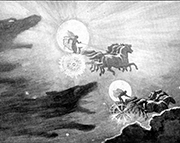E-Archive
Off the Beaten Track
in Vol. 15 - March Issue - Year 2014
Wolves in the Sky

Skoll and Hati chasing the Sun and the Moon

Geometric method by Aristarchus
They stood shoulder to shoulder in perfect silence, gazing intently up at the sky. It was a chilly autumn night on the high mountain plain. The light of the full moon glinted off the row of shields held upright at the soldiers' feet. The short puffs of vapor issuing in rapid succession from their nostrils were the only sign of any emotion.
A tiny sliver of a dark shadow suddenly appeared on one side of the bright lunar disk. This was the signal, and the group erupted as one man in a frightening roar. The black spot spread across the moon's face and the furious howls, growing louder and louder, were accompanied by the heavy, rapid thumping sound of swords on shields. The din would continue for at least two hours...
*******
Since time immemorial, lunar and solar eclipses have been the source of awe and fear. No rational or logical explanation could be given, so humanity turned to the supernatural and the mythical. In China, India and in many areas in Asia and South America, people believed that dragons or demons were attacking the Sun. The ancient Mayans thought that a jaguar was swallowing the Moon. Among Scandinavian tribes, it was said that the wolf Skoll was trying to devour the Sun, while its brother, the wolf Hati, was chasing the Moon.
For all of these ancient civilizations, the only way to defend the two heavenly bodies would be to scare the attackers off by hurling stones and spears, screaming curses and by making much noise and commotion.
However, there were some who realized that lunar and solar eclipses were natural phenomena and who based their astronomical studies on these events.
Aristarchus, a Greek mathematician and astronomer who lived between 310 and 230 B.C., was the first to calculate the relative size of the Sun and the Moon and the relative distance between them. By careful observation and geometrical analysis based on the size of the Earth's shadow during a lunar eclipse, Aristarchus concluded that the Sun must be much larger than the Earth. Yes, but how much larger? And what about the relative size of the Moon? What proportion was there in the distances between Earth, Moon and Sun? To answer these questions, the Greek mathematician developed a remarkable geometric method. Ancient astronomers had already arrived at the conclusion that the Moon shines by reflected sunlight, so Aristarchus reasoned that by measuring the angle between the Moon and the Sun when the Moon was exactly half illuminated, it would be possible to calculate the ratio of their sizes and of the distance between them. He estimated the angle to be 87¢X, which meant that the ratio of the distance was sin 3¢X (see figure - for the sake of clarity, his calculations are given here based on the modern concepts of degrees and trigonometry, although neither existed at the time of Aristarchus). This allowed him to calculate that the Sun was about 20 times as distant from the Earth as the Moon, and 20 times the Moon's size. Both of these estimates were way off the mark, but only because instruments available at that time were not accurate and not because his reasoning was wrong. It must also be pointed out that with the naked eye, it was practically impossible to determine the exact moment in which the Moon was half-illuminated. In fact, the angle between the Moon and the Sun is 89¢X 50' and the Sun is about 400 times further away than the Moon.
Aristarchus's theories and geometric arguments have reached us through his only surviving work, a book entitled On the Sizes and Distances of the Sun and Moon. However, Aristarchus is also famous for being the first to propose a heliocentric structure for our planetary system, as opposed to the geocentric system that was favored by his contemporaries. Thanks to his studies on eclipses and his observations of the heavens, Aristarchus reasoned that the apparent movement of the planets and the change of seasons could be explained only by putting the Sun in the center and by postulating that the Earth revolved on an inclined axis. His heliocentric theories were put forward in a book, which unfortunately is lost, but which was accurately described in a later work by Archimedes.
Aristarchus's theories were condemned by his peers and remained forgotten until they were revived by the Polish astronomer Copernicus 1,800 years later.
By Giovanni Gregorat, Contributing Editor MFN
Author: Giovanni Gregorat



























